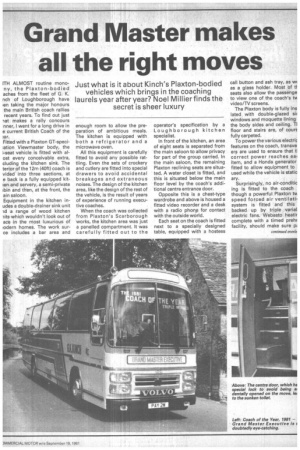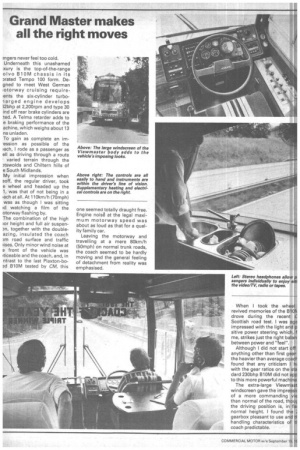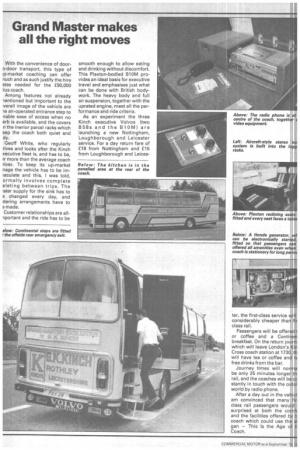Grand Master makes all the right moves
Page 53

Page 54

Page 55

Page 56

If you've noticed an error in this article please click here to report it so we can fix it.
Just what is it about Kinch's Plaxton-bodied vehicles which brings in the coaching laurels year after year? Noel Millier finds the secret is sheer luxury
ITH ALMOST routine monony, the Plaxton-bodied aches from the fleet of G. K. nch of Loughborough have len taking the major honours the main British coach rallies recent years. To find out just -let makes a rally concours nner, I went for a long drive in e current British Coaeh of the far.
Fitted with a Plaxton GT-speci:ation Viewmaster body, the -seat vehicle is fitted with alost every conceivable extra, eluding the kitchen sink. The tenor of the 12m (40ft) coach is vided into three sections, at e back is a fully equipped kiten and and servery, a semi-private :bin and then, at the front, the am n saloon.
Equipment in the kitchen inudes a double-drainer sink unit id a range of wood kitchen iits which wouldn't look out of ace in the most luxurious of lodern homes. The work surce includes a bar area and enough room to allow the preparation of ambitious meals. The kitchen is equipped with both a refrigerator and a microwave oven.
All this equipment is carefully fitted to avoid any possible rattling. Even the sets of crockery and cutlery are fitted into special drawers to avoid accidental breakages and extraneous noises. The design of the kitchen area, like the design of the rest of the vehicle, is the result of years of experience of running executive coaches.
When the coach was collected from Plaxton's Scarborough works, the kitchen area was just a panelled compartment. It was carefully fitted out to the operator's specification by a Loughborough kitchen specialist.
In front of the kitchen, an area of eight seats is separated from the main saloon to allow privacy for part of the group carried. In the main saloon, the remaining Plaxton reclining seats are situated. A water closet is fitted, and this is situated below the main floor level by the coach's additional centre entrance door.
Opposite this is a chest-type wardrobe and above is housed a fitted video recorder and a desk with a radio phone for contact with the outside world.
Each seat on the coach is fitted next to a specially designed table, equipped with a hostess call button and ash tray, as w( as a glass holder. Most of tt seats also allow the passenge to view one of the coachrs ts.A video/TV screens.
The Plaxton body is fully ins lated with double-glazed Si windows and moquette lining the body sides and ceiling. TI floor and stairs are, of cour.i fully carpeted.
To power the various electric features on the coach, transve ers are used to ensure that tl correct power reaches ea, item, and a Honda generator fitted to allow equipment to used while the vehicle is static ary.
Surprisingly, no air-conditic ing is fitted to the coach though a powerful Plaxton tv■ speed forced air ventilati, system is fitted and this backed up by triple vadat electric fans. Webasto heatir complete with a timed preh( facility, should make sure pi
„rigers never feel too cold.
Underneath this unashamed xury is the top-of-the-range o lvo B1 OM chassis in its prated Tempo 100 form. Degnecl to meet West German lotorway cruising require ents the six-cylinder turbolarged engine develops 32bhp at 2,200rpm and type 30 ind off rear brake cylinders are led. A Telma retarder adds to e braking performance of the achine, which weighs about 13 ns unladen.
To gain as complete an im • ession as possible of the )ach, I rode as a passenger as ell as driving through a route • varied terrain through the nswolds and Chiltern hills of e South Midlands, My initial impression when ?off, the regular driver, took e wheel and headed up the 1, was that of not being in a lach at all. At 110km/h (70mph) was as though I was sitting id watching a film of the otorway flashing by.
The combination of the high or height and full air suspen30, together with the doubleazing, insulated the coach )m road surface and traffic iises. Only minor wind noise at e front of the vehicle was iticeabie and the coach, and, in ntrast to the last Plaxton-bop,c1 B1OM tested by CA4, this one seemed totally draught free. Engine noise at the legal maximum motorway speed was about as loud as that for a quality family car.
Leaving the motorway and travelling at a mere 80km/h (50mph) on normal trunk roads, the coach seemed to be hardly moving and the general feeling of detachment from reality was emphasised. When I took the wheel revived memories of the B101% drove during the recent C Scottish road test. I was aga impressed with the light and p sitive power steering which, f me, strikes just the right balan between power and "feel".
Although I did not start off anything other than first gear the heavier than average coach found that any criticism I hi with the gear ratios on the sta dard 230bhp B1 OM did not app to this more powerful machine
The extra-large Viewmast windscreen gave the impressi( of a more commanding vie than normal of the road, thouc. the driving position is, in fat normal height. I found the ; gearbox pleasant to use and ti handling characteristics of tf coach predictable.
)ri the open road, I found that .ping the engine revs in the :en band on the rev counter qween 1,500 and 2,200rpm)
coach was responsive and ooth. With the engine turning ar at about 1,500rpm the 3ch pulled happily at 80km/h 1mph). Accelerating in the 3rs when the revs reached the 00 mark, a surge of smooth wer provided rapid acceleran sufficient for any eventual
3raking performance seemed II matched to the vehicle, with electric Telma retarder erated by either foot or hand itrol allowing smooth and íabraking without too much of isk of spilling passengers. A foot operated exhaust brake is standard equipment on the B1OM chassis.
A highly equipped executive coach, like a luxury limousine is built with passenger comfort uppermost in mind and is thus unlikely to be driven particularly fast around corners and I found that the feeling of luxury about the Grand Master Executive seemed to discipline me against driving hard around corners to check the roll characteristics of the coach.
In any event, the high floor vehicle rolled less than expected and the ride from the full air suspension was a little firmer than expected and very difficult to criticise. I drove the coach on narrow winding roads, in busy town streets, and, for a short spell, on the M40 and, in a way, was sorry to arrive at our destination as I felt I could have happily continued driving for a lot longer.
During the M40 stretch, the coach pulled up Stokenchurch Hill in sixth gear and if I had not needed to slow down because of slower vehicles in front, maybe we could have climbed the hilt at a speed of at least 96km/h (60mph) without needing to change down.
The executive coach is potentially one of the most comfortable forms of travel and I found this particular B1OM well deserved its rally accolades. Its performance and ride characteristics ensure that the facilities aboard can all be used to practical advantage without passengers being constantly reminded that they are on the road by pitching of the vehicle.
Its limitations seem few, and its specification obviously the result of practical experience.
Our route was from Hemel Hempstead to Coventry on the M1 and M45 and then through Stratford-upon-Avon to the Cotswolds. The 3.8m (12ft Sir overall height of the vehicle (du to the TV aerial mounted on th roof) meant that from Stratford was not possible to take th Broadway road because of a lo% bridge.
We did, however, take the ne> available route through the Cots wolds to Burford and the Minster Lovell on the old A4( From there we followed the A4 to the Oxford by-pass and th M40 to Stokenchurch Hill. The down into High Wycombe an on to the A404.
The big Volvo climbed W) combe Hill in third gear with rE markabte and surprising ease.
From High Wycombe ou route was through the Buckinc hamshire towns of Amershar and Chesham and them to Berl hamsted, where we rejoined th A41 to our starting point E Hemel Hempstead. It took u about six and a quarter hours t cover the 305km (188.4 mile: route at an average speed c 48km/h (30.15mph).
In conclusion, the Kinch Gran Master Executive offers car-lik performance with the comfort c first-class rail, and the potenti; for the standard of service ai lines strive for. With fuel cor sumption normally around te miles a gallon the vehicle more fuel-efficient than many c its rivals. With the convenience of dooro-door transport, this type of !p-market coaching can offer nuch and as such justify the hire ates needed for the £90,000 lus coach.
Among features not already nentioned but important to the verall image of the vehicle are le air-operated entrance step to nable ease of access when no erb is available, and the covers n the inerior parcel racks which eep the coach both quiet and dy.
Geoff White, who regularly rives and looks after the Kinch xecutive fleet is, and has to be, ir more than the average coach river. To keep its up-market nage the vehicle has to be imlaculate and this, I was told, ormally involves complete aleting between trips. The 'ater supply for the sink has to changed every day, and )tering arrangements have to a made.
Customer relationships are allnportant and the ride has to be smooth enough to allow eating and drinking without discomfort. This Plaxton-bodied B1OM provides an ideal basis for executive travel and emphasises just what can be done with British bodywork. The heavy body and full air suspension, together with the uprated engine, meet all the performance and ride criteria.
As an experiment the three Kinch executive Volvos (two B5 8s and the BlOM) are launching a new Nottingham, Loughborough and Leicester service. For a day return fare of £18 from Nottingham and £15 from Loughborough and Leices ter, the first-class service will considerably cheaper than fir class rail.
Passengers will be offered 1 or coffee and a Continen breakfast. On the return journi which will leave London's Kin Cross coach station at 1730, th will have tea or coffee and tv free drinks from the bar.
Journey times will norma be only 25 minutes longer th rail, and the coaches will be cc stantly in touch with the outsi world by radio phone.
After a day out in the vehicl am convinced that many fir class rail passengers would surprised at both the comft and the facilities offered by t coach which could use the sl gan — This Is the Age of ti Coach.








































































